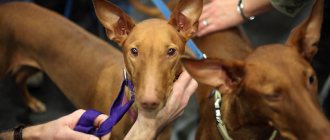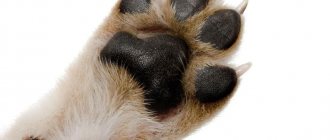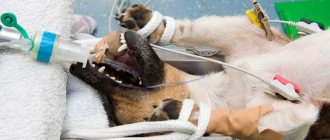What is a general dog training course (GTC)?
Every pet has a character, but while a nasty hamster can be left alone, you can't do the same with a dog. The owner is responsible for the behavior of his animal at home and on the street; the dog must be obedient and follow the owner’s commands. Then his interaction with people will be successful.
The general dog training course was developed almost 100 years ago by the Soviet dog handler V.V. Yazykov. Since then, it has hardly changed and has not lost its relevance. It includes practicing basic skills and commands. Owning them will help you manage your dog in everyday life, successfully serve with it and exhibit at competitions.
Service animals usually undergo several specialized courses; they are not allowed to participate in them without the OCD.
What is ZKS
The protective guard service is a system whose goal is to raise an animal capable of guarding and protecting its owner, property, and recognizing and distinguishing odors.
There are many training systems, but this is the most effective. For ZKS, only healthy, large individuals are selected (at least 60 cm at the withers), with good physical characteristics, healthy, strong teeth, ideal sense of smell, hearing, and vision. With such qualities as courage, energy, distrust of strangers, balanced nervous system. A dog for service is selected as a puppy, when its qualities are already visible.
PCL learning occurs through 3 basic instincts:
Take the Attention Test! Find 10 differences! (click right here!)
Find the answer Are you bothered by some problem or question? Enter “Breed” or “Name of the problem” into the form, press Enter and you will find out everything about the issue that interests you.
- Social. Expressed in interaction with others.
- Protective. Allows the dog to behave aggressively.
- Hunting is the dog’s innate instinct to chase and grab prey.
What skills does training provide?
Skills developed during the learning process:
- The ability to distinguish the owner's things from others by smell.
- Protection of the owner and his property.
- Refusal of food given by a stranger.
- Detaining a criminal, escorting him.
- Lack of cowardice when firing a weapon.
- Search the territory.
- Understanding the "Fu" command.
Who is this course for?
Any dog needs the basics of training, but first of all you need to go through them:
- Puppies that will be exhibited in the Russian Cynological Federation (RKF). A document confirming that the standards have been passed is a mandatory condition for a participant in the competition.
- For kids of fighting breeds. Due to their temperament, it is more difficult for such dogs to restrain aggression, and the power they possess is dangerous for others. You must be confident in your pet.
- Police dogs and rescuers. Animals undergo several training courses, OKD first and these.
- Service pets (guide dogs, guards, bloodhounds, shepherds).
OKD is the basis; there is also a full training course, which must be completed by those who will work in protective guard, guard, and patrol services.
What is included in the general course?
The course can be taken at a dog training school or independently. OKD for dogs at home may differ slightly from the classic version, since each owner himself determines which commands his pet will not need.
The following skills are typically practiced:
- Execution of commands (“Lie down”, “Sit”, “Voice”, “Come to me”, “Place”, “Nearby”, “Fetch”).
- Training in wearing a muzzle (the dog should be allowed to put it on and walk quietly), showing a grin (needed for brushing teeth and checking the bite).
- Passing barriers.
There can be two training sessions per day, each lasting 1-2 hours. The number of commands worked depends on the dog’s level of training and endurance. They start with 2-3 skills, gradually increasing their number.
Beginning owners are wondering at what age can a dog take the course? They begin training after six months, but individuals at least one year old are allowed to take the exam. Dog breeders consider the optimal age for OKD to be 8-10 months.
Team “Nearby”
A command used every day. It will make your walks with your pet much easier. The skill is for the dog to walk next to the owner, his shoulder should be at the level of your leg.
During the test, the handler will turn, change pace, or stop to test command. The animal should not lag behind. Points for exercises are not counted if the dog deviates to the side by more than 2 meters.
"To me"
One of the most necessary commands, it will be useful both at home and on a walk, in everyday life and at work. Most dogs pick it up quickly. When checking, the trainer says the phrase “Come to me” and makes a patting motion on the thigh. The dog should immediately come and sit to the left of the owner or in front of him. If the animal does not respond to the command within 15 seconds, the skill is not counted.
"Place"
If you conduct an OKD course for dogs on your own, then with the command “Place” the dog should learn to take his bed. At the training ground, the “place” is an object familiar to the animal. The skill is tested in a comprehensive manner.
The owner orders him to lie down, after which he places a toy next to the pet. Gives the command “Place” and goes about 15 meters (in the field of view of the subject). Half a minute later the order “Come to me” is given. The dog approaches and is sent to the “place”. He must return and lie down no more than 1 meter from the thing. In other cases, the skill is not counted.
Complex “Sit, lie, stand”
The commands listed above are checked in any order, but this complex always goes together. The skills of “sitting” and “lying down” are usually consolidated by six months; training to “stand” requires more time, and is often learned by 9 months.
When checking, the owner alternately gives orders with voice and gestures. The dog must do them the first time. After the “Sit” command, the owner must move 10-15 meters away from the dog; the animal must not move from its place.
The pet has moved more than 5 m - the exercise does not count. Commands were not executed the first time - points are reduced.
Importation
The “Fetch” command is necessarily included in the general dog training course. You can also teach it yourself without a coach, but this skill is not always necessary in life. The ability to fetch will be useful for physically active breeds; it will be easier for you to walk them and direct their energy in the right direction.
It will not be possible to pass the OKD exam without apportation. It is checked as follows:
- The trainer introduces the animal to the object that will need to be brought.
- Gives the command “Sit” and throws the thing 10 meters or more.
- There is a pause of 10-15 seconds.
- The command “Aport” sounds.
The subject must take the toy, return to the owner, and take a place at the left leg. On the command “Give”, give the item. Points are deducted or not counted at all if the animal does not take the item, does not bring it, or throws it halfway and then picks it up. If it returns to the owner only on the command “Come to me”.
Prohibition of taking food or objects
Training in endurance and understanding the word “impossible” in life is necessary. The prohibition of unwanted actions is made with the words “fu”, “impossible”. During the exam, he is tested on his desire to take food or a toy (another object).
In the case of food, the owner sits the dog down and treats him with a treat from the palm of his hand several times in a row. On the 4th-5th piece the command “” sounds, the tasty food is removed. Next, the trainer throws the toy, sends the dog after it, and then gives the same forbidden command. The pet must spit out the object.
If the dog violates the prohibition 2 times in a row, the command is considered not executed.
Reaction to the sound of a gunshot
The OKD exam for dogs (RKF standards) necessarily includes checking the reaction to a shot. You need to accustom your pet to loud sounds from early childhood, because it is impossible to protect him from explosions of fireworks, thunder or other annoying noises.
To pass the test, the dog must not be afraid of gunfire. When completing the exercise, the pet is next to the owner and performs the command “Sit” or “Lie down”. At a distance of 15 meters, a shot is fired from the starting pistol. The animal should stay in place and not run away. The skill is not taken into account if the subject stopped executing commands or got scared.
The command “Show your teeth” and wearing a muzzle
All dogs need the ability to show their teeth on command. This way, the owner can safely carry out cleaning; the bite is checked at exhibitions and at a veterinarian’s appointment. Wearing a muzzle is a demonstration of submission, a safety measure. The dog should walk quietly in it.
When checking, the owner first gives the command “Show your teeth,” then puts on a muzzle and sends him for a walk. After a short pause, the trainer releases his mouth. The exercise will be valid if the pet reacts calmly to all manipulations and does not growl or try to remove the muzzle.
Overcoming obstacles
When preparing a dog for OKD tests, you need to take into account that it will have to show its physical fitness and overcome obstacles. The lane will randomly contain a ladder, an inclined wall, a fence, a trench or a boom.
During the test, the owner moves with the animal. He stands to the right of the object and gives the command “Forward” or “Barrier”. It is prohibited to assist your pet mechanically.
How to teach a puppy to call by its name?
First you need to make sure that the puppy remembers its name, this may take three days. To do this, you need to buy his favorite treat and every time the puppy calls out his “name”, praise him with the exclamation “Good” and give him a treat. Then you should repeatedly praise the baby and stroke him, while repeating the nickname.
Every time you give your baby food, you should call him by name and when he comes running, you should praise him with the command “Good.” While the baby is eating, call him by his nickname a few more times.
The main task before the owner is to teach the puppy to instantly call out his name when he gets carried away with the game or when other stimuli appear. For example, you need to wait until the puppy shows great interest in something and at this time you need to loudly call his name. At the same time, it is better to make sure that the dog sees that you have in your hands some of its favorite things. After the baby comes running, give him a treat and say “Okay.”
A little later, the puppy will increasingly call out his name, so it’s worth slightly reducing the rewards with treats and replacing them with the usual word “Okay,” while stroking the baby for obedience.
Next, the training should be a little more complicated. For example, when you call out to a dog, saying its name, add the command “Come to me.”
When teaching a puppy his name, many owners make the following mistakes:
- You can’t call your baby by his name loudly, because he might get scared.
- You should not call your puppy his name every time you address him, because over time he will stop responding to it.
- There is no need to constantly say the puppy’s name during any command, because over time he will get used to it and will not do anything that is said without the name.
Minimum score table
Based on the results of passing the OKD for dogs, diplomas of various degrees are issued (or the exam is not counted):
| Skill | Evaluation of the dog's performance | |||
| Highest score – 100 points | Diploma 1 – 90 points | Diploma 2 – 80 points | Diploma 3 – 60 points | |
| "Near" | 10 | 9 | 8 | 6 |
| "To me" | 10 | 9 | 8 | 6 |
| "Place" | 10 | 9 | 8 | 6 |
| Complex commands | 10 | 9 | 8 | 6 |
| Importation | 10 | 9 | 8 | 6 |
| Prohibition of taking food and objects | 10 | 9 | 8 | 6 |
| Reaction to the sound of a gunshot | 10 | 9 | 8 | 6 |
| "Show your teeth" | 10 | 9 | 8 | 6 |
| Overcoming obstacles | 10 | 9 | 8 | 6 |
| Dog activity, general impression | 10 | 9 | 8 | 6 |
For each skill you can get a maximum of 10 points, penalties for performing each of the commands are prescribed in the OKD standards.
Team "Quiet"
This command is necessary in order to stop the animal in time when overcoming obstacles, when the dog is in free movement without a leash and in other situations. When the dog moves slowly, then you can observe its behavior.
Training using ocd is used when it is necessary to develop character in a dog.
For example, in order for a dog to master the “Quiet” command, it should be used when it goes through an obstacle course.
To do this, put the dog on a short leash. Start walking forward at a normal pace, giving the dog the command “Nearby”, then slow down and voice the command “Quiet”. In order for the animal to understand what they want from it, you should pull the reins in your direction with small jerks. If it performs the task assigned to it, it must be stroked, praised and told “Good”.
After this, you need to check the dog when it walks along a log or ladder. If she slows down after hearing the “Quiet” command, she must be praised and the “Quiet” command clearly pronounced again.
To reinforce the command, it must be said several times.
During training you should not make the following mistakes:
- Pull the reins hard when training.
- Keep the reins in a constantly taut position.
- It’s too early to start practicing by removing the reins from the dog.
Price of OKD course for dogs
Now you know what is included in the OKD course for dogs, its necessity becomes obvious. The question of price remains. It greatly depends on the prestige of the school and its location. The average cost looks like this:
- 1000-2000 rubles for one group lesson;
- 2000-3000 rub. for individual.
It is also possible for a dog handler to come to you, but such services will cost more. Puppies that are exhibiting must undergo training at school; without a certificate you will not be able to participate in the competition. If the question is only in education, then you know which commands are included in OKD for dogs and you can teach them to your pet yourself.
How to teach to refuse treats from someone else's hands?
There are people who just like to give treats to other people's dogs, and there's nothing wrong with that as long as their intentions are good. And if this is not the case, then the dog may suffer. This is why it is important to teach your pet not to take treats from strangers.
The main thing is to teach the dog to take treats only from the hands of the owner. This must be started when the animal already understands the commands “No” and “No”.
To prevent your dog from taking anything from strangers, you should follow these rules every day:
- Follow your diet. That is, feed the dog hourly, in sufficient quantity.
- Do not develop a greed for food in your dog; there is no need to tease him during feeding by taking away food. She should eat in peace.
- The first training lessons should begin when the dog has eaten well, and then a couple of hours after eating.
- Carefully ensure that the dog does not pick up anything on the street or take a treat from the hands of a stranger.
To consolidate all this, you need to place a feeder with food in front of the animal and not allow it to eat for a few seconds, saying the command “No”. After a certain time, about thirty seconds, give the command “Eat.” Carrying out such training daily, the waiting time increases to ten minutes.
After the dog has fully learned the lesson, you should begin to wean it from taking treats from someone else's hands; this could be your helper. Sometimes a soft rod is used for training. It is used for punishment if the animal is nevertheless tempted by someone else's delicacy. To do this, you need to lightly hit the dog on the front paws, this will help the dog understand that this should not be done.
To believe how an animal will carry out a command, you should tie it to a tree and hide. Then your assistant should approach her with a treat and a twig, and if she takes the treat from him, he should hit the animal on the paws several times. Afterwards, you must voice the command “Face” and at the same time sharply point your hand at the assistant. If your pet reacted correctly to this on its own, then you should praise the dog and say “Good.” After a certain period of time, the situation must be repeated.
After doing this about three times, your assistant should leave, but at the same time throw a piece of meat on the floor. If the dog reacts to this and tries to get it, it is necessary to stop the attempt with the command “No”, and at the same time pull the reins towards you. If, on the contrary, the animal does not react to the meat, then it should be praised and petted. This situation should be played out four times a day, changing the location, people and treats.
When the dog understands that it is impossible to take food from a stranger, you need a second person to throw food from afar and leave.
Later, you need to teach the dog not to pick up food from the ground. To do this, it is necessary for a stranger to scatter treats in different areas on the ground. You must walk your dog on a leash through these areas. When the animal, based on the smell, moves in the right direction, and when it finds it is trying to eat food, you must sharply pull the leash in your direction and strictly give the command “No”. If there is no reaction from the animal, simply go through all the areas.
When conducting such OCD training for dogs, most owners make the following mistakes:
- Classes are held in one place.
- The same type of treat is used.
- At the end of training, the dog is allowed to eat the food that has been laid out.
- The dog is given strong blows with a rod.
- In the process of giving the “No” command, the owner shouts too much.
- You jerk the reins sharply in your direction.
- Conduct the first classes when the animal is hungry.











